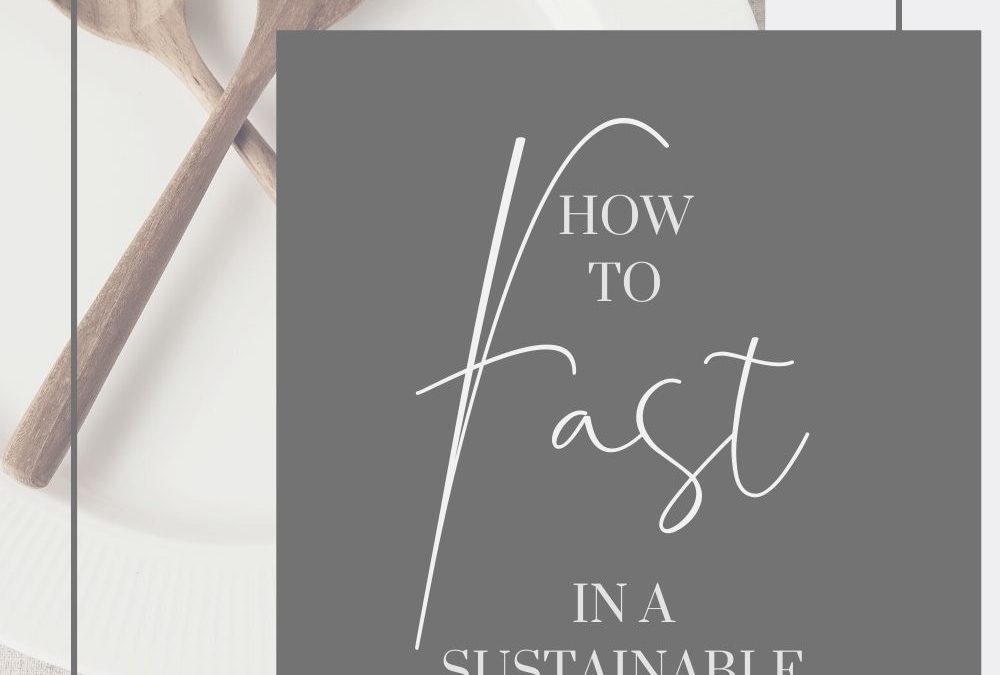The days will come when the bridegroom is taken away from them, and then they will fast. – Matthew 9:15
If we are disciples of Jesus, we should be fasting – and not just during Lent, but all the time!
Problem is, it is WAY too easy to make excuses and justify ourselves out of a calling that can seem daunting and uncomfortable.
But what about when the “excuses” are justified, and traditional fasting is simply too much. How can we experience the benefits of fasting in a more sustainable way, that is approachable for more people?
What is Traditional Fasting?
Traditional fasting consists of 1 meatless meal per day, with 2 smaller (also meatless) snacks, that together do not equal a whole meal. It means not drinking anything besides water or black tea/coffee.
Traditional fasting is associated with not eating before noon, or not eating after lunch (if lunch is to be your main meal).
It has specific guidelines only so that it is simple and straightforward and one can easily say, I fasted or I broke my fast.
The point is that fasting is meant to deprive the body, not just of excesses, but also of some of its legitimate needs so that the fast is truly FELT in the body. If you are “fasting” without feeling hungry, then you are doing it wrong.
The Problem with Traditional Fasting
In the “old days”, from the old testament all the way up to the Great Depression, people were accustomed to hardship. They knew how to live it well and come out stronger on the other side.
The problem with traditional fasting is that it is very difficult and often unapproachable for normal modern person. We are unused to going without food so our body may not respond well to sudden harsh deprivations, often becoming quite ill or non-functional.
Also, this type of fasting is almost always unreasonable for children, sick people, elderly people, pregnant or nursing mothers, or anyone with physically demanding professions.
Does that mean Traditional Fasting should be discarded?
NO. Absolutely not! In fact, this is where our society is going terribly wrong. They think that because it is difficult, even to the point of being considered impossible by some, that it needs to be pushed away because it might make people feel bad for not being able to do it.
We have to change this!
The problem isn’t with the traditional fast,
the problem is the fact that, in general, our modern life of privilege has made us too weak to handle it (both mentally and physically). When we realize this, we realize that the traditional fast has not lost its value but precisely the opposite, it has become even more important to remind us what we are capable of!
The intensity of a traditional fast is a truly beautiful experience of closeness with God, and an unprecedented and unparalleled experience of communion with grace (ie. divine strength) that doesn’t exist anywhere else in the spiritual life and is largely inexplicable to one who hasn’t experienced it before.
It is a little bit like watching the intensifier in a workout program and wondering if one day you’ll ever be able to do what they do.
So, don’t think impossible – think aspirational!
How to Fast (from food) in a more Sustainable Way
Meanwhile, for us “normal people”, let’s look at how to fast in a more sustainable way. Another way to think about this would be like a fasting “modifier” for beginners, or for people who need to dial down the physical intensity but not the challenge.
Think about fasting as tiny acts of self-denial throughout the day
Sample Ideas:
- Fasting from second helpings
- Eat slower. Practice savoring and be grateful for your food. Stop when you are about 80% full.
- Always drink at least 8oz water before eating.
- Don’t take the last one (cookie, meatball, hotdog, whatever)
- Fast from desserts/sweets/sugar
- No fast food/junk food
- Don’t use salt
- Have bread without butter or coffee without cream
- If you prefer your coffee hot, drink it cold
- If you have an affinity for ice, especially if you chew it, give up ice in your drinks.
- Choose good, old-fashioned still water (over soda/juice/carbonation)
- “Betcha can’t have just one?” Well, try just having ONE! Or, one small serving, or one LESS than you wanted
- Don’t eat by yourself
- Don’t complain about food (Eat what you need to eat and be grateful.)
- Don’t eat between meals
- Don’t taste your food while its cooking, or eat the crumbly edges
- Don’t go shopping, use the stuff in your pantry instead
- Stick to a meal plan
- Learn to cook well (ie. healthy and delicious)
- Give up a TYPE of food (ie. meat, dairy, eggs, fruit, etc)
- No hidden food stashes
- Don’t run to food for comfort
- Don’t go to restaurants
- If you DO go to restaurants, don’t get french fries, sodas, or candy bars in the checkout line (all the upsells) when you go out
- Instead of giving something up, what if you chose to eat something you don’t like (but you know is good for you), like all your veggies? 😉
Choosing your Fast
Obviously, it’s a bit ridiculous to imagine doing everything on the above list all at once, especially if the whole point of this post is to figure out how to do a fast that is actually reasonable and sustainable, so let’s look at how to pick what to do.
#1 – Use your fast to turn something you been NEEDING to do (but have been dreading/avoiding/procrastinating), into something you CHOOSE to do.
This is like letting God design your fast. Embracing what needs to be done is PLENTY. Don’t try to be impressive and do more.
- If your health requires you to adjust a specific part of your diet, just embrace that. (ie. no salt, no sugar, no complaining about allergens, etc)
- If you have been working on dieting but you just can’t manage it, do a portion control fast.
- If you know you have a specific addiction you know you’ve been needing to break (ie. sugar, alcohol, etc), give that up for your fast (or moderate it, as opposed to going off cold turkey). (ex. only 1 cup of coffee per day, as opposed to 6)
- If the idea of fasting is just completely overwhelming, or you are scrupulous about feeling like you have to do everything you think about, maybe you shouldn’t be fasting at all (fast from fasting) and simply be intentional about your food choices, focus on gratitude for food, and a healthy relationship with food. (Ex. this would be especially good for families who need to learn to stick to meal plans and get grocery shopping under control, or for people who struggle with undereating, or eating disorders)
#2 – Um, there is no #2 –
Unless you have already completely mastered all the items in the list above and incorporate them all seamlessly and simultaneously into your daily routine on a regular basis… In which case, my friend, you are ready for the traditional fast. Congratulations!
How to Fast – An Attitude Shift
What’s the difference between dieting and fasting? (I feel like I need to make this into a whole other post in this series, it’s such a big deal).
The difference is Motivation (Purpose).
- Dieting focuses on improving the body. Fasting focuses on transforming the soul.
- Dieting is motivated by what you GET out of it. Fasting is motivated by what you GIVE.
- Dieting is begrudgingly controlling our food intake because we HAVE TO, either because medical reasons require it in order to accomplish a specific health/weight loss goal. Either way, the end result is typically solely motivated by self-improvement / self-love (of course, you can also diet for the sake of your kids or your spouse, but the goal is still solely physical transformation).
- Fasting is voluntarily giving up food as a sign of love. Fasting says, “Lord, I love you more than a hamburger.” or “I want to love you more than this handful of M&Ms”.
- Dieting is something you white knuckle your way through on sheer will power alone. Fasting is something you do when you can’t do anything else (ex. I wish I could help Linda with her cancer problem, but there’s nothing I can do. If giving up this piece of chocolate could make her life easier, would I do it?).
- Dieting can’t touch our soul. Fasting transforms both soul AND body.
BOTH serve to show us our priorities in life, our strengths, and our weaknesses. But LOVE is ALWAYS a more powerful motivator than self. This is how fasting has greater capacity for transformation.
When to Fast
Obviously, you can fast whenever, wherever, and however long you want, or whenever you feel inspired.
But, for beginners and extreme fasters, it can be very helpful to put specific timelines on their fasts. You can do chose any length that is significant to you but a common timeline is, 1 day, 3 days, 40 days, 1 year, 3 years, until a specific date/event, etc.
The goal is to develop a sustainable lifestyle that contains elements of fasting in general with spurts of deeper intensity for specific purposes.
- if you are preparing spiritually for a special event – ie. Easter, Christmas, getting married, etc.
- if you are discerning God’s will on anything important – getting married, accepting a job, deciding to move, etc…
When Fasting Fails
The good news: true fasting never fails. The bad news? True fasting is hard to master.
Fasting doesn’t “work” when:
- it’s really just about trying to lose weight (primary motive) – Trust me, this just makes for the world’s most horrible diet.
- we are looking for attention or trying to appear “holy” – making sure everyone else knows about “all the things’ we are doing
- we make it too easy on ourselves – Did it even count?
- we are trying to quid-pro-quo God into doing our will – ex. I will give up sweets if you will make my football team win, or so that I will win the lottery. Even if our intention seems good, ie. for someone else to change, or that my dog won’t die – it is more important that we pray to accept God’s plan for every situation and that whatever happens, we will know and have the courage to do what WE need to do in every circumstance.
True Fasting – A Checklist
Always double check:
- That your fasting plans are complementary to your state in life (your age, your health, your profession) and not contrary
- That your fasting plans are in place BEFORE you begin your fast – don’t plan to wing it, this is a recipe for doing absolutely nothing, or for stressing out that you aren’t doing everything
- That your fasting plans are S.M.A.R.T. (Specific, Measurable, Attainable, Relevant, and Time-Bound) in order to be successful
- That your fasting plans actually challenge you
- If fasting isn’t hard, you aren’t doing it right
- Fasting is a form of Death-to-Self and Self Mastery – it needs to feel uncomfortable in order to change you
- You must challenge yourself to make progress
- BUT, like any good workout: Make sure you aren’t doing more than is healthy (or safe), “Listen to your body”, Push yourself but don’t injure yourself
And NEVER FORGET
- Fasting is an honor and an opportunity (not a drudgery)
- Fasting is about LOVE – not being impressive
Do not not appear to others to be fasting… – Matthew 6:16
Rend your hearts, not your garments… – Joel 2:12
Share below: How do you incorporate fasting into your daily life? Did I miss any good ways?
Other great blog posts on traditional fasting that might help you!
- Spiritual Fasting – A Lady in France
- What is fasting – SusanEvans.org (+ series, including Seeking Wisdom during a Fast)
- 10 Practical Tips for Easy Fasting – FromHisPresence.com
- Bible Verses About Fasting – Bible Study Tools.com
- 3 Life-Changing Reasons to Fast – ArabahJoy.com
#ParticularlyCALLED #Togetherinthetrenches #IamCALLED
[mailerlite_form form_id=1]


